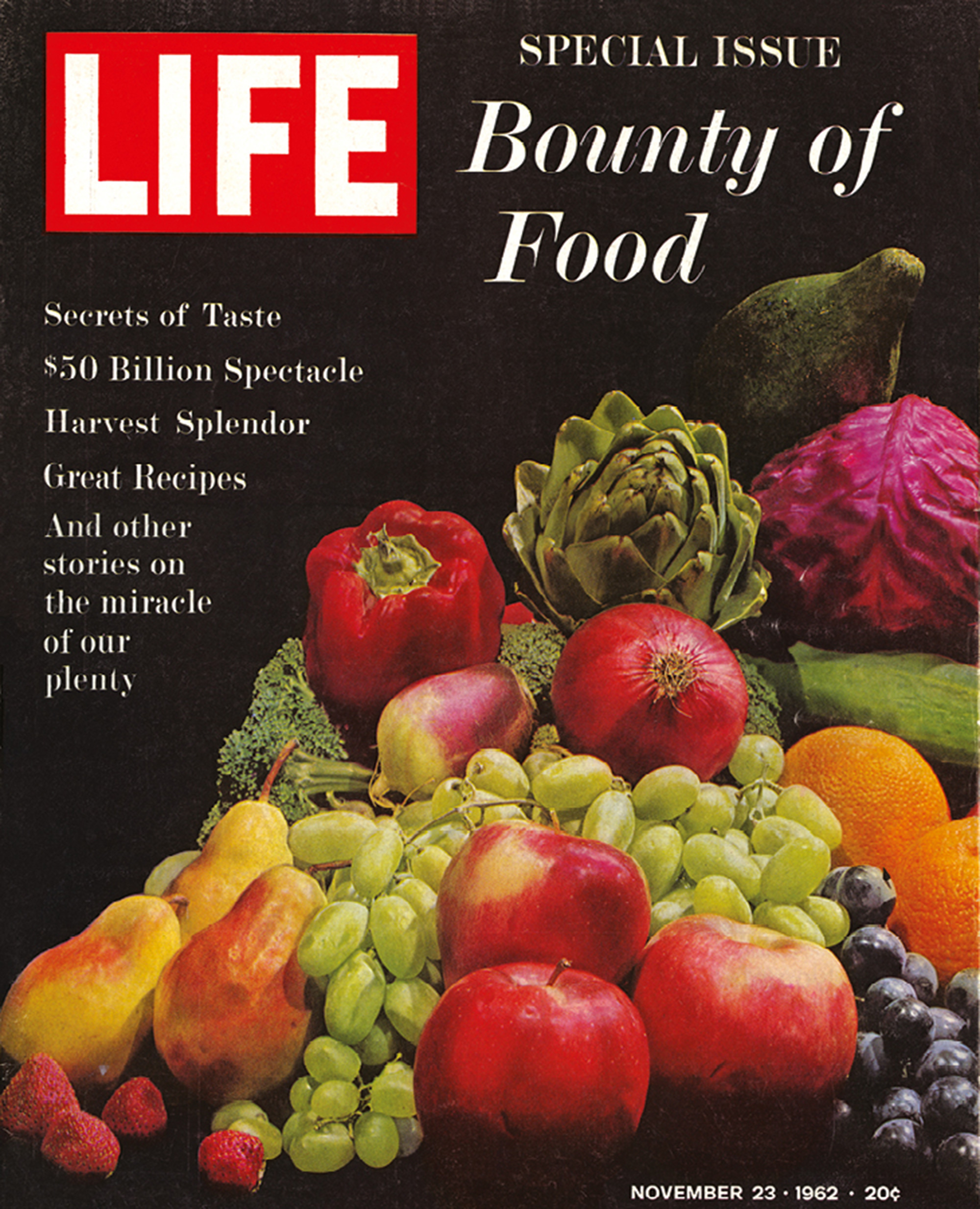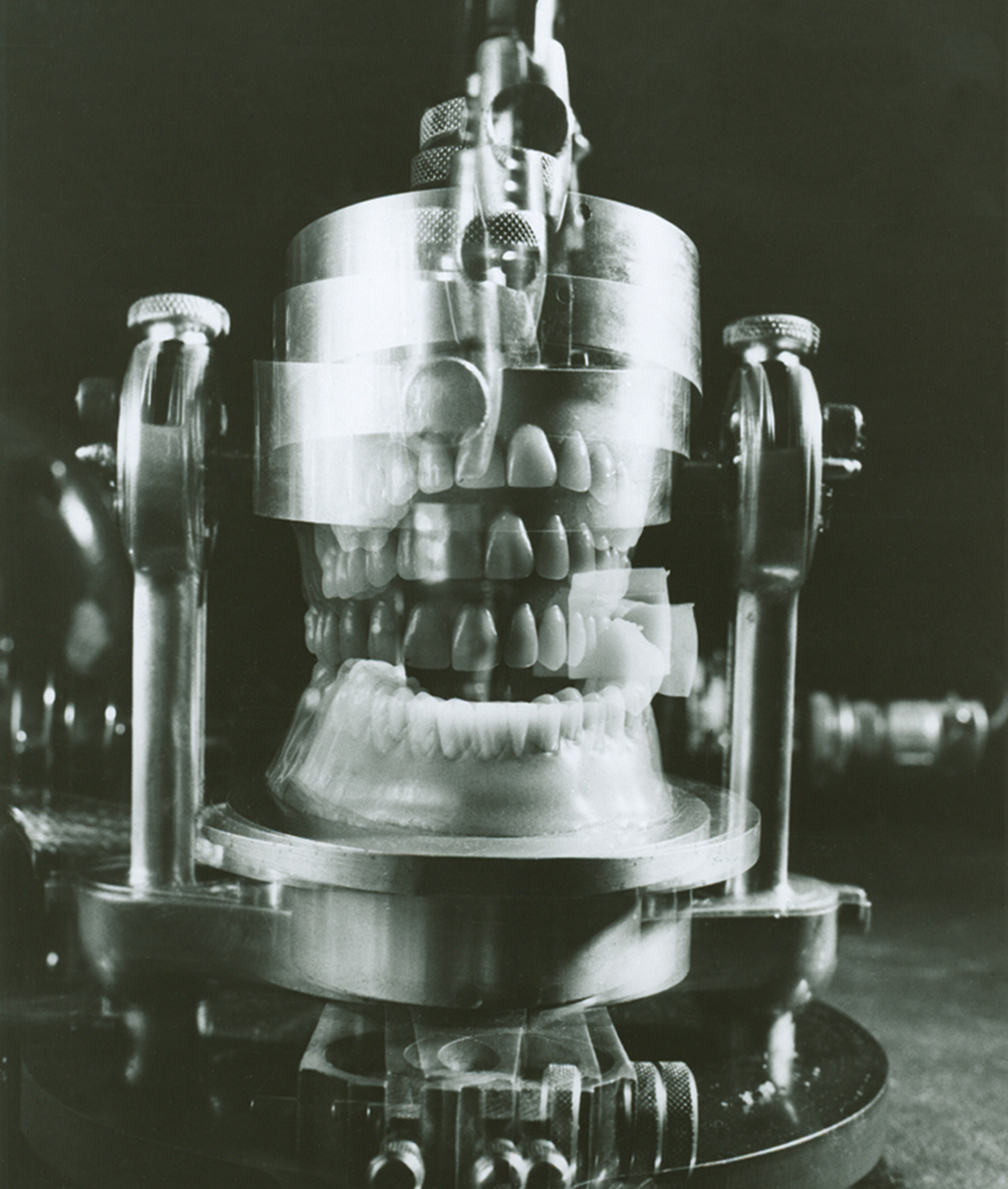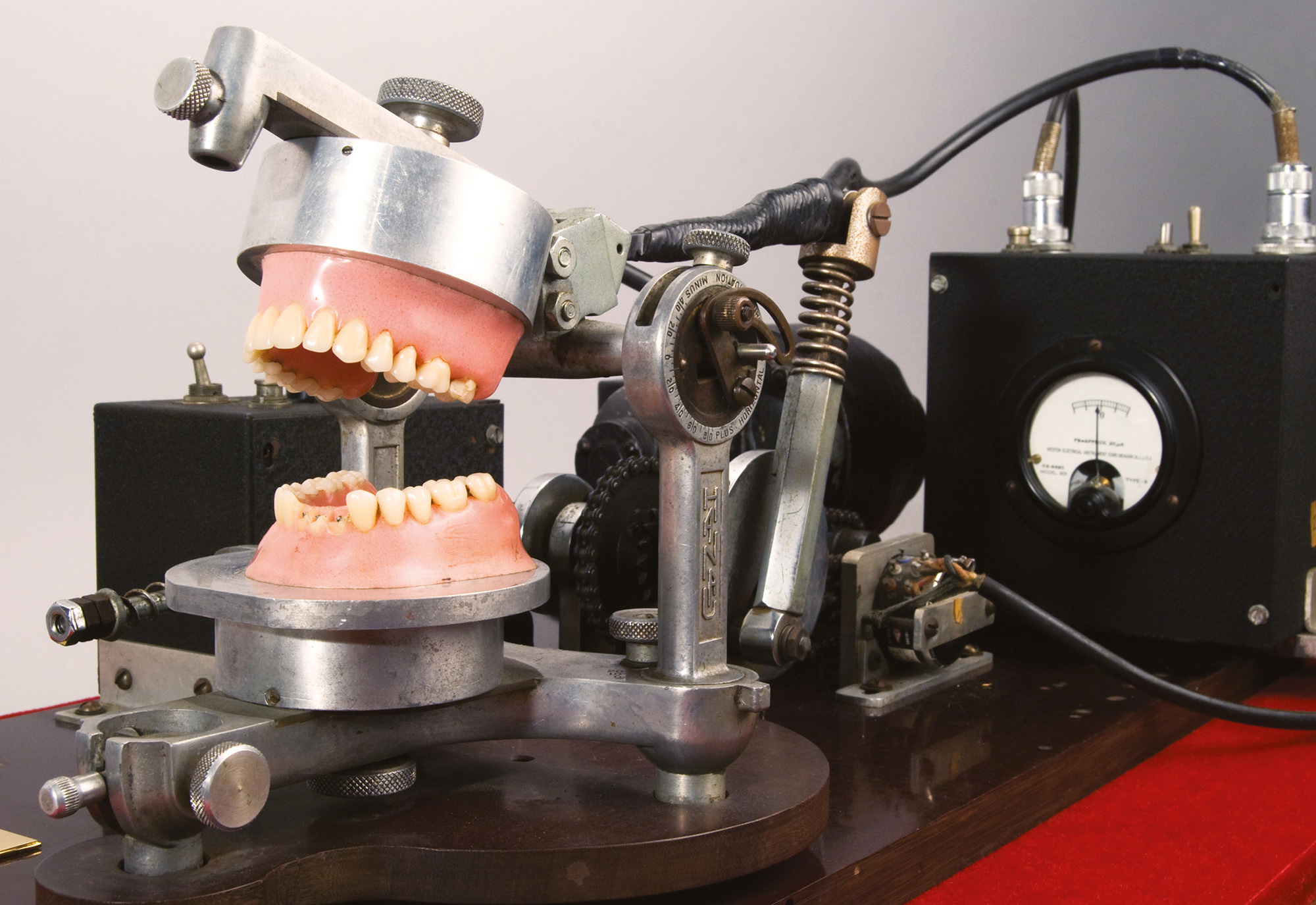“Ingestion” is a column that explores food within a framework informed by aesthetics, history, and philosophy.

On 23 November 1962, Life magazine released a special Thanksgiving issue dedicated to the “Bounty of Food.” Images of verdant vegetables and fruits were coupled with photographs of “mountains of butter” and a “hot dog highway,” all attesting to the natural wealth and industrial innovation of US agriculture. Celebrating the superiority of American industrial farming during the Cold War, the issue included political editorials like “The High Cost of Marx on the Farm” and “Relax on Cuba? No,” as well as scientific pieces like “Cracking the Secret Riddle of Flavor,” an essay by Warren R. Young, former science editor for the magazine. One year after his essay “Food that Isn’t Food” and two years before he published his essay “Op Art,” Young’s essay on flavor investigated the real, often deceptive variables that affect human sensitivity to and judgment of food: smell, taste, and texture, as well as sight and sound.[1]
Young interviewed leaders from both the food industry and academia on how flavor is physically and psychologically controlled and tested. Accompanying images of men, or “high priests in business suits” as Young called them, sniffing coffee and cloves, tasting popcorn, or washing their tongues off with water to deaden saliva illustrated the complexity of evaluating flavor and texture through organoleptic sensations. The last image was the only photograph without a human subject tasting or sniffing a product: a pair of acrylic gums and dentures, clamped to a metal contraption, appeared poised to chomp on a chunk of apple wedged between the upper and lower molars. The device, never named beyond a “machine that simulates chewing,” was said to precisely measure and graph chewiness, crispness, and texture. In other words, it was to correlate subjective interpretations of masticatory processes with quantitative data.
Sensory analysis in food science measures visual properties in terms of size, shape, and color. Touch is measured in terms of weight, surface, and consistency, all of which together make up texture (or mouthfeel) analysis. Unlike size, shape, and color, texture is a particularly difficult case for the correlation of physical measurements and sensory perception. One of the principal means of perceiving texture in the mouth is through mastication. And yet, beyond visually and mechanically imitating human mastication, it remained unexplained, both in the text and images, how exactly this prosthetic mouth graphed and measured biting and chewing.
But a regular reader with a good memory might have recalled seeing this pair of dentures showcased in the magazine six years before. “Baring its fangs like a starved wolf,” began “A Masticating Mechanism” on page 56 of the 29 October 1956 issue of Life. The article continued, “The fearsome-looking robot at left is about to do its job as a precision-testing apparatus.” A product of the Food and Technology Department at MIT, the robot, known as the Strain Gage Denture Tenderometer (SGDT), was about to chomp a cube of mozzarella. The SGDT—a pair of acrylic gums and dentures with detachable plastic lips all attached to two aluminum jaws—was used to simulate the process of human mastication. As in the photo in Young’s essay six years later, all that was shown of the machine were the mechanical jaws and acrylic dentures as they moved vertically and laterally—the electronic hardware, such as the oscilloscopes and Polaroid cameras used to quantify and visualize the mastication process, was cropped out. The only way to learn more about the SGDT, and, for that matter, why it was innovative, was to either subscribe to Food Technology or read “Masticatory Properties of Foods by the Strain Gage Denture Tenderometer,” a 273-page dissertation completed by Aaron Leo Brody in 1957 at MIT.
Building on the 1937 article “Apparatus For Measurements of Chewing Resistance or Tenderness of Foodstuffs” by Nikolaus N. Volodkevich at the University of Karlsruhe’s Institute of Refrigeration, and on the post-World War II research at Tufts College’s dental school and the US Office of Naval Research which used a gnathodynamometer and strain gauge to measure the forces involved in biting and chewing, the SGDT used two oscilloscopes to simultaneously measure force-time and force-penetration in the mastication process.[2] A force-time diagram charts the variation of force in relationship to time. It is useful in determining the tenderness of an object. A force-penetration diagram, “probably the most significant impression obtained in the mastication of a food by an individual,” measures “force exerted as a function of distance between the teeth during the chewing process.”[3] Brody produced force-penetration diagrams by attaching input and output transducers to the mechanical parts of the SGDT in order to convert into electric signals the mechanical resistance produced when food samples were placed between the motor-driven dentures. The cathode ray oscilloscope modified these electric signals, visually intermixing force and penetration functions. Brody likened this to the way “information is sent to the brain and feedsback [sic] to the mouth either to adjust the masticatory force or to speak and express a linguistic interpretation of the sensation. Thus, in instrumental terms, the human mouth is the output transducer.”[4] His SGDT, he claimed, simulated how the human mouth masticates while electronically duplicating the accompanying brain sensation a person experiences when chewing. Oscillographic photographs, taken by the Polaroid cameras mounted to the device, allowed Brody to average and standardize subjective experiences and interpretations. He compared and contrasted not only different foods but also the same food in different varieties and at different stages of freshness. “The Strain Gage Tenderometer,” wrote Brody, “has thereby simulated the human system for commercial purposes by averaging the human masticating mechanism, standardizing its nervous system, and then applying a many-brain interpretation to the data obtained.”

Experimenting on biscuits, frozen shrimp, peas, cakes, canned whole kernel corn, ice cream, lima beans, and chewing gum, researchers found that the SGDT correlated with “conventional organoleptic techniques and industry standards.”[5] If this was true, then Brody had figured out how to objectively simulate human subjectivity. In refining and further calibrating the SGDT to produce objective measurements, Brody also tested and diagrammed the effects of age on the plasticity of foods. For instance, Brody charted the tenderometer value of starch jellies from zero to seven days old on force-penetration diagrams. He also used the SGDT to verify that cheese gets harder in the open air than if it is stored in a refrigerator.[6] And while the SGDT used fake human teeth to duplicate chewing surfaces, simulated crushing and grinding, and instantly transmitted the forces “encountered by the jaw muscles in chewing” to the output devices, Brody conceded that the SGDT could not mimic three crucial aspects of human mastication. First, the machine was unable to simulate the complex movement of the jaw and how it adjusts to changes in resistance throughout the process of mastication. In other words, as Warren R. Young noted, it chomped “rapidly but dispassionately.”[7] Second, the SGDT did not produce saliva (but later iterations included adding saliva to the SGDT). And lastly, it did not have a tongue, lips, cheeks, and “other fleshy portions of the mouth” to move food around “so as to expose a fresh surface for biting.”[8] Although Brody never described the SGDT as a robot in his dissertation, it convincingly quantified and modeled the human experience of mastication. He did, however, claim that it was surpassed only by “the human masticatory process.” [9]

For Brody, the instrument finely and objectively measured “some previously intangible and unmeasurable subjective masticatory properties of foods,” which he subdivided into four distinct scales: hardness–softness, elasticity–plasticity, crispness–brittleness, and toughness–tenderness. And while he claimed to have objectively measured a fifth scale, crumbliness–cohesiveness, the results were not conclusive.[10] Before Brody’s SGDT, numerous technologies existed to quantify qualities such as tenderness, texture, and shear, to name a few. For instance, pea tenderometers, a popular instrument used by the US Department of Agriculture in the 1940s and 1950s to test the maturity of peas, determined their tenderness by measuring the weight needed to pierce their skin. Innovations in pea tenderometers led to other devices to measure tenderness in relationship to force, such as the Christel Texturemeter, which determines the forces needed to press several rods into a specific volume of material contained in a box or cup. By the 1950s, the Bloom Gelometer tested gel strength in marshmallows and jellies, the grease penetrometer measured the firmness of unctuous materials like oils and fats but also chewiness in semi-solids like soft candies or mayonnaise, and the Warner-Bratzler Shear Force Machine measured meat quality in terms of shear. Brody cited the importance of all of these instruments in the collective pursuit of objective measurements; however, he believed that the divergence of opinion created by each specialized device, combined with a general dearth of information on mastication, necessitated a new research approach. Whereas previous devices only measured a single operation of mastication, the SGDT simultaneously simulated the complex processes of chewing and biting. Furthermore, Brody believed he had successfully correlated “results with specific definitions.”[11] In doing so, he defined an objective nomenclature of subjective, organoleptic sensations.
And yet, why are objective definitions of texture like crispness and plasticity important? One reason, as Brody puts it, is commercial: “Often without being conscious of it, an individual will base a large part of his quality evaluation of a food upon its masticatory properties. These properties constitute significant percentages of the US Department of Agriculture grade scores of many canned and frozen vegetables such as peas, corn, lima beans, and asparagus.”[12] This was of great concern, both to the producer and consumer, especially as more and more fruits and vegetables and baked goods were being frozen and refrigerated for long periods of time, altering their masticatory properties and affecting their acceptability to consumers. In 1961 alone, Americans “emptied enough food cans to stretch to the moon and back 3 times.”[13] The following year, Life magazine estimated, the food industry would spend over $100 million inventing and developing new products, twice what it spent in 1957.
The major practical and epistemological feat of devices like the SGDT designed to quantify texture was to objectively define subjective characteristics such as plasticity and crispness. But their role was not simply to assess canned peas and frozen corn; they were also instruments that gathered the quantifiable data needed to artificially replicate certain gustatory experiences.
In attempting to translate intangible descriptions into measurable effects, Brody aimed to mechanically and electronically map the correspondence between physical changes and psychological changes. Because an individual’s subjective assessment of physical factors does not necessarily resemble objective measurements, Brody suggested averaging the point at which a majority of individuals’ subjective interpretations of the smallest perceptible differences coincided. Where a majority of these subjective interpretations coincided with objective measurements, one could establish a threshold.[14] Mapping a series of thresholds allowed a researcher to quantify degrees of qualitative difference, say between “soft” and “softer.” The physical and psychological correspondence Brody sought represented what chemist and rheologist G. W. Scott Blair defined as “psychorheology.”[15] If rheology is the study of the flow and deformation of matter, then psychorheology uses data from physical tests to understand subjective assessments of these material qualities. And, in fact, Brody cites Blair’s 1939 essay, “Psycho-rheology in the Bread-making Industry,” as the basis for the correspondence between psychological and physical changes. By combining psychology with rheology, Blair attempted to objectively link knowledge gained from subjective assessments such as texture, touch, masticability, and vision with physical measurements such as size and volume. His research varied from studying cervical mucus to creating a pachimeter to measure the plasticity of clays; however, the majority of Blair’s work focused on measuring human sensations (like touch and texture) and the plasticity of physical objects (like curd and cheese) in relation to one another. Not unlike Brody, Blair was particularly interested in knowledge transfer between connoisseurs and artisans, such as bakers and cheesemakers, and industrial technicians. As more and more food was canned, refrigerated, and frozen, food producers went to great lengths to make it look, taste, and feel natural rather than artificial. The necessary addition of preservatives and chemicals put further pressure on food producers to manufacture deceitful sensations and sentimentality.
In his introduction to the 1953 edited volume Foodstuffs: Their Plasticity, Fluidity, and Consistency, Blair observed that one of the areas where molecular models are not entirely adequate is in “that little-studied Gestalt, ‘Masticability’, which undoubtedly depends on chemical and physical factors.”[16] The assessments made by industrial manufacturers, trained human testers, and consumers of foodstuffs are inherently subjective, and, thus, for Blair, “necessitated a psycho-physical approach.” He cited The Scientific Study of Personality (1952) by German-born British psychologist Hans Jürgen Eysenck, where he, according to Blair, “draws interesting parallels between stresses and strains in the human personality (together with the causes of its breakdowns) and recent theories concerning the failure of metals.”[17] By invoking the techniques of the physical sciences in conjunction with those of psychology, Blair, like Brody, was taking on one of the most pressing practical and theoretical questions confronting the food industry: Is there an objectivity to subjective assessments?
Blair believed that there was such an objectivity, indeed one that was commensurate with the physical sciences. To this end he, along with Byron C. Veinoglou and John Espenett Caffyn, theorized a system of “quasi-properties,” which measured a process of change in materials like plastics and pastes, rather than a stable state. In other words, “quasi-properties measure an ordered process towards equilibrium rather than a state of equilibrium.”[18] Blair and his co-authors did not directly apply quasi-properties to taste, but they did to firmness and plasticity, two criteria of texture. While Blair continued to explore quasi-properties in works like Measurements in Mind and Matter (1956), he found few supporters, or indeed foes, of the concept.
Quasi-properties aside, Blair’s conceptualization of psychorheology, like Brody’s SGDT, found success, establishing standards of nomenclature in the field of food science. Both Blair and Brody promoted their work through industry publications, finding a receptive audience to their ideas. Perhaps the most significant patron of their work was Dr. Alina Surmacka Szczesniak, a food technologist at General Foods in New York. In her 1963 article “Objective Measurements of Food Texture” published in the Journal of Food Science, she used a classificatory system devised by Blair in 1958, dividing devices for measuring texture into three categories: fundamental, empirical, and imitative.[19] Fundamental tests measure rheological properties in terms of calculating the rate of strain on a material (flow) and the ratio of stress to strain on a material (elastic moduli). Empirical tests involve devices such as penetrometers, compressors, consistometers, and shear measures, among many others. Imitative tests model the conditions to which the material is subjected in practice. Szczesniak extolled the SGDT as the best example of an imitative device, and credited it with making way for the Texturometer, a device said to give “good correlation between instrumental values and subjective evaluation.” The Texturometer is commonly used in the industry today.
• • •
In 1974, Blair published “Psychorheology—Links Between the Past and the Present” in the Journal of Texture Studies, a periodical he co-founded in 1969. He likened psychorheology to psychophysics, a science dedicated to measuring sensations. And while he agreed with Henri Bergson that it was not possible to measure sensations by ratios, or by intervals for that matter, but he did not see any contradiction in the possibility of making an ordinal scale, where “with luck, the intervals will, in fact, correspond fairly well with the equal intervals measured with an instrument.”[20] Here, once again, Blair and Brody’s attempts at linking mind and body, sensation and material, coincide.
By invoking a new metrology of sensations, Blair and Brody both aspired to conflate the binary relationship between natural and artificial, invoking a new way of relating humans to the objects they craft and ingest. Their research attests to the production of knowledge around the functions and mechanisms of what were thought to be the “minor senses”—taste, smell, and touch—all of which are integral to foodstuffs, as well as larger debates about subjectivity. The history of their work adds another dimension and scale of intimacy to the history of perception, told through mastication and texture.
Anthony Acciavatti is a PhD candidate in the history of science at Princeton University. He is a partner in Somatic Collaborative.